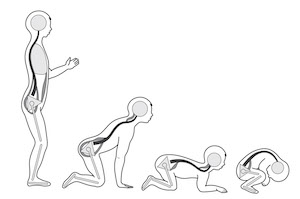If you look up the medical definition of “posture” you will find simplistic explanations yet the true definition is far more complex and comprehensive.
- Posture is the ability in minimize forces and stresses on the body throughout movement and in a static postural positions.
- Postural stresses affect more than just the musculoskeletal system but affects the organs, nervous system, brain function, circulatory system, lymphatic system, and a whole
lot more. - Maintenance of posture is mainly reflex function; changes are made by the nervous system
Poor Posture Definition
- Decreased efficacy of the muscular system as more muscles are under tension and some tissues absorb abnormal load (joints, muscles, fascia, nerves, ligaments)
- Increased load can cause pain and premature degenerative changes.
- Increased muscle activity can lead to fatigue,decreased circulation, accumulation of metabolites.
- Shortening & lengthening of soft tissues results in abnormal movement patterns
Neutral Spine Definition
- When the normal spinal curvatures are maintained
- Least pressure on the tissues around the spine
- Best position for the recruitment of muscles around the trunk

Development of Spinal Curves
Posture constantly happens in two environments, (static and dynamic) and in three planes (Sagittal, frontal and transverse).
Anatomically, posture is dependent on the inter-action of the skeletal, muscular and non-contractive connective tissue systems (including fascia, tendons and ligaments).
Biomechanically, the complex stress structure of complementary forces created by these three systems also makes erect, balanced posture possible.

Muscular System and Posture
Balance between antagonistic muscle groups.
Constant muscle tone facilitates balance and stability in body joints.
In normal posture, antagonistic muscle groups work in different directions in order to stabilize the body and keep it in a state of balance.
Upsetting this functional balance between opposing muscle groups may lead in time to the development of postural disorders (Kendall & McCreary, 1983).
Organ System and Posture
The respiratory system found mainly in states of kyphosis and scoliosis, because of pressure on the chest cavity.
The digestive system in situations entailing defective positioning of the pelvis and weakness of the abdominal and lower pelvic muscles.
Circulatory System
The circulatory system (in disorders that interfere with normal blood flow as a result of malalignment of the various joints).
Nervous System
The nervous system which is affected mainly by pathologies connected to the functioning of the cervical, thoracic or lumbar vertebrae of the spine.
Skeletal System
Optimal load on the skeletal system.
Despite its physical rigidity, bone tissue is dynamic in nature and responds to loads imposed on it.
The study of bone growth indicates that bone grows in direct proportion to the load placed on it, within physiological limits.
In postural disorders, there is an imbalance in the loads imposed on different areas.
In these situations where loads exceed normal physiological limits consistently and over prolonged periods of time, structural changes occur in the skeletal bones.
Damage of this type is usually regarded irreversible however this may not always be the case.
Body movement and body posture are represented by different brain regions. Movement perception relies on the motor structures of the frontal lobe. Probably, the most important brain region for the representation of body posture, in contrast, is the Superior Parietal Lobule (SPL). This region is known to integrate signals from different sensory modalities, and damage to it results in dysfunctions of posture perception and actions requiring postural adaptations. However, other brain regions are involved in posture processing as well.
Whereas limb movement perception seems to rely on motor structures, multisensory parietal areas are especially important for the maintenance of a postural representation.
Reference: The Neural Bases of Multisensory Processes, CRC Press
The finding that cross-modal influences in sensory-specific occipital cortex can take posture into account suggests that intermediate brain structures representing the current posture are also involved.
Postural signals have been found to affect activity in many different regions of the brain, including fronto-parietal areas that also participate in attention control and multisensory processing (Andersen et al. 1997; Ben Hamed and Duhamel 2002; Boussaoud et al. 1998; Bremmer et al. 1999; Kalaska et al. 1997; Fasold et al. 2008). Hence, we can hypothesize that the fronto-parietal cortex may also take part in stimulus-driven multisensory attention control.
Reference: The Neural Bases of Multisensory Processes, CRC Press
Posture is the foundation of movement, correcting movement wont necessarily improve the foundation, the posture; rather it may create adaption protocols in the motor structures.
